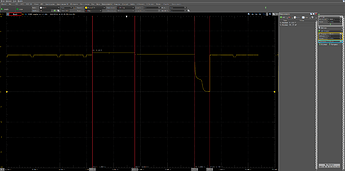I currently use three LiPo Rider Plus boards inside small acquisition modules.
Aside from the annoying fact that when the USB-C port loses power, the 5V output turns off and then on, with about a seconds delay. I have now noticed that with only the battery connected, with and without load, the 5V out dips from 4.9V to 3.7V every second or so. Does this indicate a faulty module?
I’m hesitant to disassemble the remaining two modules to test the other LiPo RIder Plus boards.
Any insight may help.
@nino.benci Yes, you’re right. Here is the waveform of power plug in and pull out.
Maybe we can talk about the next generation of lipo rider?
Hi Bruce.
Happy to chat.
The current version is a power bank solution. The original intention of the design is a small power board with typec and typeA interface. Since TyeC is popular now, many users use C-C line, so our type C port needs to have the current output function. The same port as input and output will cause the main controller to shut down the output for a while when switching functions. We are looking for a suitable solution. What suggestions do you have?
Hijacking this thread with a response.
The Lipo Rider Plus should have the following bare minimum requirements:
-
Boost voltage (not just pass through power) from USB source to 5.1 V to recover voltage lost from long USB cables and support Raspberry Pi and other devices that require >5.0 V.
-
Switching between battery and USB power without loss of power. This should be possible if boosting both sources, rather than just battery. Refer to PowerBoost 1000C by Adafruit as an example.
-
JST connector should be moved/rotated to not be on the same side as the USB-C port. This will allow the module to be put inside a case with an internal battery, but external USB-C connection.
